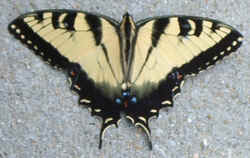 |
||
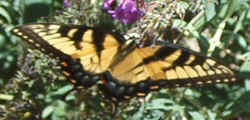 |
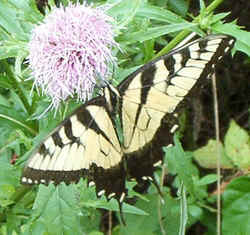 |
|
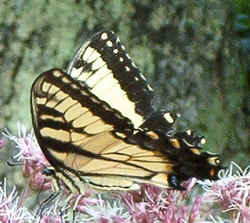 |
||
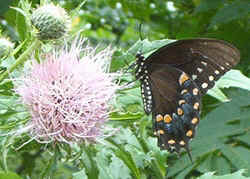 Female Dark Form |
Tiger Swallowtail
Scientific Name: Papilio glaucus
Family Name: Papilionidae
Serendipity Ranch
Columbus, North Carolina
 |
||
 |
 |
|
 |
||
 Female Dark Form |
In 1587, John White, a colonist in the service of Sir Walter Raleigh, drew an illustration of the tiger Swallowtail. His model was a butterfly he collected on Roanoke Island -- then part of the colony of Virginia. Sometimes classified in the genus Pterourus. Identification: Wingspan 3 1/8 - 5 1/2 inches. Overall yellow with black stripes and tails. Above: shows black border; hindwings with some bluish iridescence and orange eyespots. Below: row of separate yellow markings on outside edge of forewings; most markings on hindwings border are orange (see Papilio rutulus). Dark female form occurs in some areas. Habitat: Woodland edges, meadows, parks, and suburbs. Range: Alaska and Canada southeast to Florida and Gulf of Mexico; east of Rocky Mountains. Life Cycle: Caterpillars feed on a variety of deciduous trees, including willows (Salix spp.), cottonwoods (Populus spp.), wild cherries (Prunus spp.), and yellow-poplar (Liriodendron tulipifera). Adults, 1 - 3 flights per year. [Walton, Richard K., National Audubon Society Pocket Guide; Familiar Butterflies of North America, Alfred A. Knopf, Inc., New York, 1996]
Male and some females above and below are yellow with black tiger-stripes across wings and black borders spotted with yellow. Long, black tail on each hindwing. Hing wing above and below usually has row of blue patches inside margin, with orange spot above and sometimes much orange below, running through yellow. Dark form females are black above with border-spotting of yellow, blue, and orange (blue someitmes becomes cloud on hindwing), below brown-black with shadowy "tiger" pattern. Yellow spots along outer edge of forewing below and separate in all but norhternmost populations. Most have orange uppermost spot on outer margin of hindwing above and below and orange spot on trailing edge. [Pyle, Robert Michael, Audubon Society Field Guide to Norht American Butterflies, Alfred A. Knopf, New York, 1981]
Butterfly and Moth Home Page * Butterfly and Moth Books * Nature Lovers